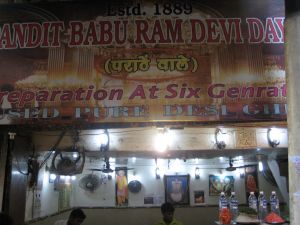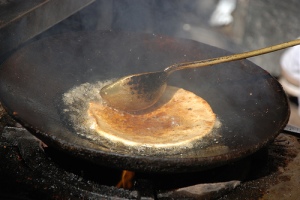The Paranthas are one the very few forms of Delhi’s street food, that have kept their linkages with their past origins. This food form originated in ancient North India and is still prepared in the same way.
Paranthas have traveled across the entire country and even spread to several others, on trade routes as well as migration ones. No other street food essential has been more experimented with than the paranthas, becoming an indispensable part of home kitchens and restaurants as well as remaining on the Street stalls.
The following is an attempt to mark out the several forms of Paranthas as well as popular parantha haunts that spread across the entire length and breadth of the capital.
****
Dictionary Reference:
Parantha: A type of unleavened bread, fried in oil and clarified in butter.
Paranthas:
Parantha is a flatbread that was conceived in ancient North India especially in the region of Punjab. It is usually made with whole-wheat flour, pan fried in ghee or cooking oil, and often stuffed with vegetables, especially boiled potatoes, radish or cauliflower and/or Paneer (cottage cheese). A parantha (especially a stuffed one) can be eaten simply with a blob of butter spread on top but it is best served with pickles and yoghurt, or thick spicy curries of meat and vegetables.
Some people prefer to roll up the parantha into a “pipe” and eat it with tea, often dipping the parantha into the tea.
They can be either round, square or triangular in shape. In the former, the stuffing is simply mixed with the kneaded flour and the parantha is prepared like the roti, but in the latter two, the peda (ball of kneaded flour) is flattened, the stuffing is kept in the middle and the flatbread is now closed around the stuffing like an envelope. The two variants differ in the fact that while the former is like a thick (in terms of width) version of the roti with filling inside; the latter two, have discernible soft layers if one “opens” the crispier shell layers.
The parantha has a social connotation too. The significantly higher expenditure and effort in preparing the parantha when compared with the daily roti means that the parantha is reserved as a special item, or for important guests.
Paranthe Waali Gali
(literally: Street of Paranthas)
Located in a bylane, just of the main street in Chandni Chowk, after Sisganj Gurudwara, Paranthe Wali Gali is one of the still surviving relics of the mughul rule in India and is estimated to be almost 300 years old. As per oral accounts the Gali’s acclaimed parantha selling establishments were owned originally by a single family, who separated due to family feuds and set up their own shops.
Chandni Chowk has been a home for diverse religious and ethnic groups, so the Gali has seen its fair share of history. In the past, the Gali had over ten to twelve shops parantha selling shops, but today there are only five left.
Kanwarji Bhagirathmal Dalbhajiwallah’s 150 years old confectionery shop graces the entrance to the gali. This shop is well known for its namkeens like dal bhuji (fried pulses), aloo ka lachha (spicy fried potato spirals) and sweets like barfi and imarti. In 1984, the anti-Sikh riots had started right outside Kanwarji’s, 10 feet away from the gali and the gali was completely burnt down. The shops present today in the gali were the only ones to be rebuilt afterwards.
The first parantha shop in the gali is Pandit Devi Dayal’s. Babu Ram, the seventy-year old owner of the shop sits at the entrance, overseeing the making of the paranthas. A direct descendant of the original owners, Babu Ram said that the variety that is present today is a totally new phenomenon. He says, “50 years back, the paranthas were just of 3-4 types – the usual aloo gobi and matar (potato, cauliflower and peas) ones. But today, you can get almost 20 varieties of paranthas.” Babu Ram reminisces a time when the paranthas were served to patrons seated on the floor, on leaf plates with water in clay pots called kullars. Now however, benches and tables are mandatory.
The menu at Devi Dayal’s not only lists the usual Aloo, Paneer, Gobi and Dal Paranthas, but also Kaju, Badam (Almonds), Matar, Tamatar (Tomato), Pudhina (Mint), and Mix Paranthas. Those like the kaju badam paranthas cost 25 rupees each while the normal ones are for Rs.8 to Rs.10. The Mix parantha is something to look out for. It is stuffed with a little bit of everything, from aloo, gobi, matar, tomato and paneer to cashew, almonds, pista, radish and papad (a fried accompaniment to traditional meals a little like chips). The paranthas are fried in pure ghee in cast-iron kadhais and are served steaming hot with a mind boggling variety of chutneys, vegetable pickles and raitas.
Another Parantha shop to look out for is the Kanhaiya Lal Durga Prasad’s Parantha Shop. The shop is the oldest of them all and was established in 1875. This shop boasts of over 25 varieties of Paranthas with variants like rabri parantha for those with a sweet tooth and papad parantha for the adventurous. The shop has attracted many national leaders in the past and several framed pictures on the walls provide proof for the same. One can see the first Indian Prime Minister, Nehru with his sister dining in the shop as well as his daughter Indira Gandhi, several years later.
Mounds of colorful carrot and radish pickles decorate the shop front. The cook who has been working here for over 30 years is quietly going about his work. The paranthas are rolled out on a large marble slab and are filled with the chosen stuffing. He then fries the parantha in ghee in an anghiti, (a coal stove) that he says is just the way it used to be when the shop started. The cook flicks the fried parantha into a plate kept three feet away with nonchalance.
The owner claims that his shop was a Shudh Brahmin Bhojanalay (Pure Vegetarian Eatery) and did not serve any onions or garlic. He was also quick to tell us that all the parantha shops were owned by Brahmins and were vegetarian. This reference to caste purity in cooking is a true vestige of a bygone era as very few eateries in Delhi would care about the caste of the cook. The garlic and onion ban are also indicative of the clientele of these shops as staunchly religious upper caste Hindus do not believe that onion and garlic are suitably ‘pure’ ingredients due to their aphrodisiac qualities.
Amidst all this a board on the walls of all the shops heralded the present – a sign of changing times- it said “Bisleri Mineral Water available here”. But that is not the only change says the owner.
They are even willing to pack for takeaways.










 Posted by Vmglive
Posted by Vmglive